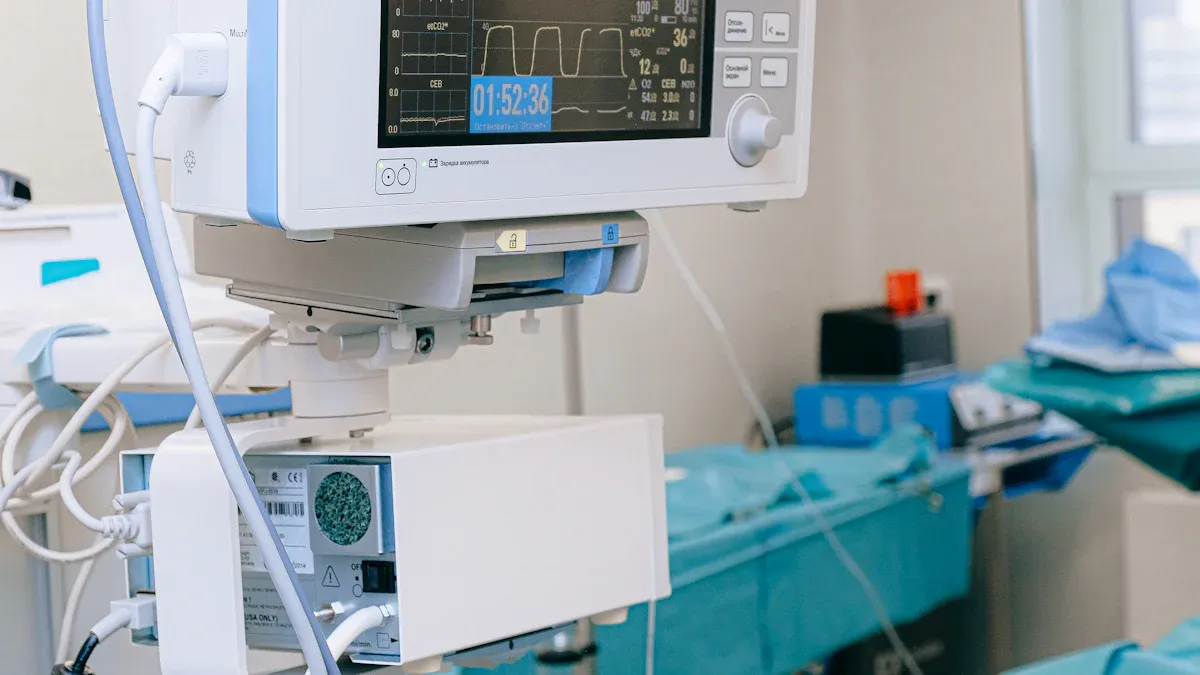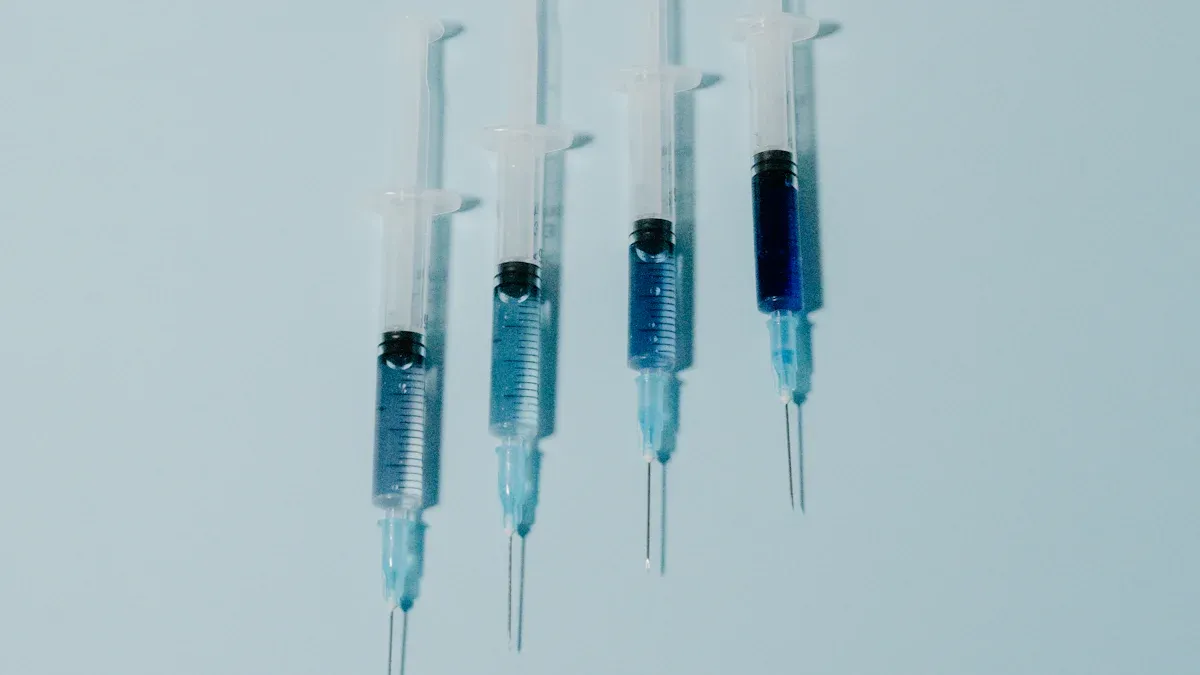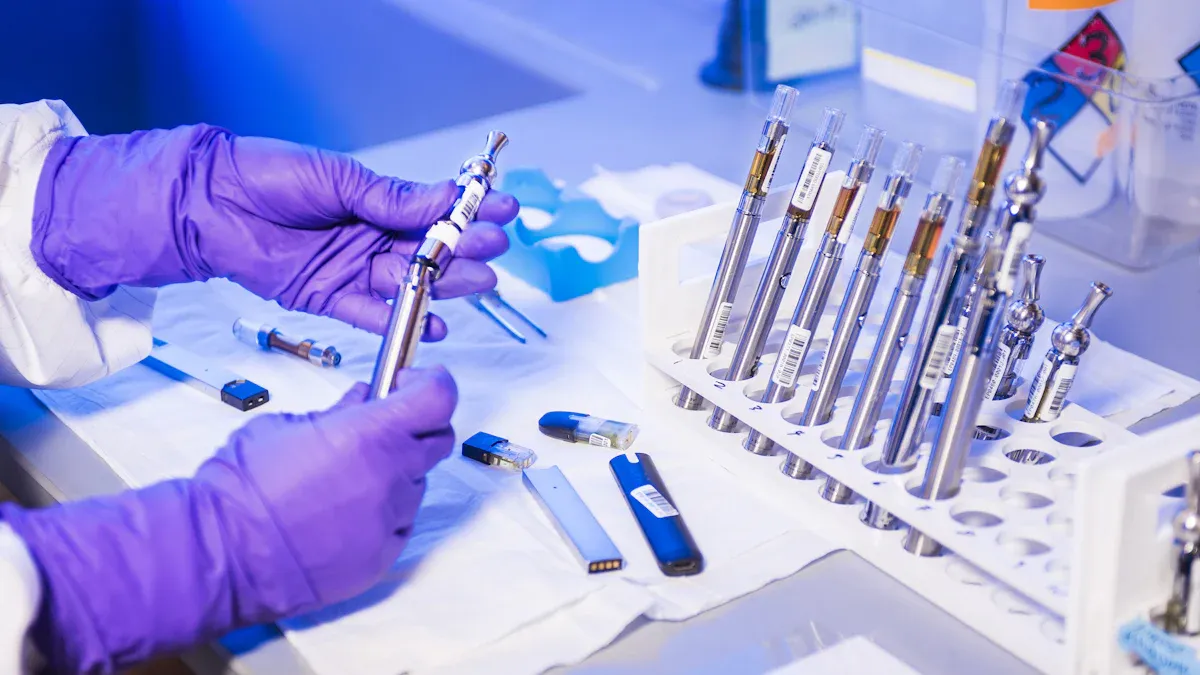What to Know About Nitinol Tubing in Medical Devices

Nitinol tubing in medical devices plays a transformative role in modern healthcare. Its unique properties, such as flexibility, biocompatibility, and strength, make it ideal for life-saving applications. Selecting the right nitinol tubing in medical devices ensures optimal performance and minimizes risks to patients. The dimensions of the tubing and the quality of the material directly impact the device's functionality and safety. Manufacturers prioritize precision and consistency in nitinol tubing in medical devices to meet stringent medical standards. By understanding nitinol's capabilities, medical professionals can choose tubing that aligns with specific application needs, ensuring compliance and reliability in critical healthcare environments.
Key Takeaways
Nitinol tubing bends easily, is strong, and safe for the body.
Picking the right size of nitinol tubing is very important.
It helps devices like stents and surgical tools work safely.
Special methods, like laser cutting, make nitinol tubing precise.
Following rules like ISO and ASTM keeps nitinol tubing safe to use.
Working with skilled suppliers ensures tubing fits its purpose well.
Key Material Properties of Nitinol Tubing

Biocompatibility and Corrosion Resistance
Nitinol tubing offers exceptional biocompatibility, making it suitable for medical applications where direct contact with human tissue occurs. Its ability to resist corrosion ensures long-term reliability, even in challenging environments like the human body. Testing for biocompatibility is crucial to confirm its safety for implantation.
The corrosion resistance of nitinol depends on its surface finish. Electropolished tubing demonstrates superior performance, with a breakdown potential of up to 1000 mV, compared to oxidized tubing, which has a breakdown potential of -117 mV.
Surface Finish | Breakdown Potential (mV) |
|---|---|
Oxidized Tubing | -117 |
Electropolished (EP) | Up to 1000 |
This resistance to degradation ensures that nitinol tubing maintains its strength and flexibility over time, reducing the risk of device failure.
Superelasticity and Shape Memory Effect
Nitinol exhibits remarkable superelasticity and shape memory properties, which are essential for medical devices requiring adaptability and precision. Super-elasticity properties allow the tubing to return to its original shape after deformation, even under significant stress. This characteristic enhances its performance in dynamic environments, such as cardiovascular applications.
The shape memory effect enables nitinol tubing to "remember" its original form and recover it when exposed to specific temperatures. Engineering analyses use methods like the bend free recovery (BFR) test and differential scanning calorimetry (DSC) to quantify this behavior:
The BFR test measures shape recovery as the material warms after deformation.
DSC determines transformation temperatures critical for performance assessment.
During the BFR test, a sample is deformed in the martensitic region, and its recovery is plotted against temperature.
These testing methods ensure that nitinol tubing meets the demands of applications requiring precise shape recovery and adaptability.
Fatigue Resistance and Durability
Nitinol tubing demonstrates exceptional durability, making it ideal for repeated use in medical devices. Its fatigue resistance ensures long-term performance, even under cyclic loading conditions. Studies highlight the impact of tube processing methods on fatigue life, emphasizing the importance of manufacturing techniques in enhancing durability.
Research compares two tube processing methodologies, TM-1 and TM-2, to evaluate fatigue life in samples representative of self-expanding stents or heart valves. Statistical analyses of microstructures reveal insights into fatigue crack nucleation and long-term durability.
Low-temperature aging improves fatigue life under specific conditions. Pre-strain and mean strain effects further enhance nitinol's fatigue properties, ensuring reliability in demanding applications.
Variations in processing methods influence fatigue life significantly. These findings underscore the importance of optimizing manufacturing processes to achieve superior durability in nitinol tubing.
This combination of fatigue resistance and durability ensures that nitinol tubing maintains its strength and flexibility throughout its lifecycle, supporting critical medical applications.
Dimensions and Specifications for Nitinol Tubing
Inner and Outer Diameter
The inner and outer diameters of nitinol tubing play a critical role in determining its functionality in medical devices. Industry standards define precise dimensional tolerances to ensure consistency and reliability. These tolerances are essential for applications requiring high precision, such as cardiovascular stents or minimally invasive surgical tools.
Nominal OD/ID mm (in) | Diameter tolerance mm (in) |
|---|---|
≤1.5 (0.059) | +/-0.025 (+/-0.001) |
1.5<OD≤6.5 (0.059~0.256) | +/-0.050 (+/-0.002) |
6.5<OD≤10 (0.256~1.2) | +/-0.075 (+/-0.003) |
Outer diameters typically range from 0.1mm to 5mm, with 1.61mm being a commonly produced size. These precise measurements ensure compatibility with medical-grade components and devices. Dimensional tolerances are critical for maintaining the integrity of nitinol tubing under stress and ensuring its performance in dynamic environments.
Wall Thickness and Uniformity
Wall thickness is another vital specification for nitinol tubing. It directly impacts the tubing's strength, flexibility, and fatigue resistance. Wall thickness typically varies from 0.1mm to 15mm, depending on the application. Uniformity across the tubing ensures consistent performance, especially in devices subjected to repetitive motion or stress.
Manufacturers employ advanced techniques to achieve uniform wall thickness, minimizing variability that could compromise device functionality. For example, electropolishing enhances surface smoothness, reducing the risk of localized stress concentrations. This process ensures that nitinol tubing meets stringent medical standards while maintaining its durability and reliability.
Length and Customization
The length of nitinol tubing can be tailored to meet specific medical device requirements. Customization allows manufacturers to produce tubing for diverse applications, including self-expanding frames and individualized implants. Reports highlight the feasibility of rapid prototyping, enabling the creation of tubing with variable dimensions for unique medical needs.
Shape-setting methods further enhance customization, allowing nitinol tubing to conform to complex geometries. This flexibility supports the development of innovative devices, such as stents and surgical tools, that require precise dimensional control. Customization ensures that nitinol tubing aligns with the unique demands of each medical application, optimizing its performance and safety.
Manufacturing Processes for Nitinol Tubing in Medical Devices
Laser Cutting and Precision Machining
Laser cutting and precision machining play a pivotal role in producing high-quality nitinol tubing for medical devices. These advanced techniques ensure tighter tolerances and smoother surfaces, which are essential for enhancing device performance. Precision laser cutting enables the creation of intricate features, allowing nitinol tubing to meet the demands of minimally invasive procedures.
Laser-cut hypotubes (LCHTs) represent a breakthrough in medical device manufacturing. They are crafted using high-precision motion control and lasers, achieving features as small as single-digit micrometers. This level of detail improves the maneuverability and functionality of devices, making them indispensable in cardiovascular and neurovascular interventions.
Innovation | Description |
|---|---|
Precision Laser Cutting | Enables production of tubing with tighter tolerances and smoother surfaces. |
Advanced Machining Methods | Contributes to the reliability of nitinol tubing in critical medical applications. |
These methods ensure that nitinol tubing meets stringent medical standards, supporting its use in life-saving applications.
Surface Finishing and Coatings
Surface finishing and coatings enhance the performance and durability of nitinol tubing. Electropolishing is a widely used technique that smooths the surface, reducing stress concentrations and improving corrosion resistance. This process ensures the tubing maintains its integrity under challenging conditions, such as prolonged exposure to bodily fluids.
Coatings further optimize nitinol tubing for specific applications. For example, hydrophilic coatings improve lubricity, facilitating smoother insertion during minimally invasive procedures. Biocompatible coatings ensure safe interaction with human tissue, reducing the risk of adverse reactions. These finishing methods contribute to the tubing's reliability and longevity, making it suitable for critical medical devices.
Heat Treatment and Annealing
Heat treatment and annealing are essential steps in the manufacturing process of nitinol tubing. These processes refine the material's mechanical properties, ensuring optimal performance in medical applications. Heat treatment adjusts the transformation temperatures of nitinol, enabling its shape memory effect and superelasticity.
Annealing enhances the tubing's flexibility and fatigue resistance, making it suitable for devices subjected to repetitive motion. Controlled heating and cooling cycles ensure uniformity in the tubing's microstructure, minimizing defects that could compromise its functionality. These processes are critical for producing nitinol tubing that meets the rigorous demands of medical-grade applications.
Application-Specific Considerations for Nitinol Tubing

Cardiovascular Devices
Nitinol tubing plays a pivotal role in cardiovascular devices due to its unique properties, such as superelasticity and biocompatibility. These characteristics make it ideal for applications like stents, guidewires, and heart valve frames. The tubing's ability to adapt to dynamic environments ensures reliable performance in critical procedures. For instance, nitinol stents maintain vessel patency by resisting restenosis, a common issue with traditional materials. Guidewires made from nitinol enhance precision during minimally invasive surgeries, improving patient outcomes.
Clinical trials have demonstrated the advantages of nitinol devices over traditional materials. A comparison of key metrics highlights these benefits:
Metric | Nitinol Devices | Traditional Materials |
|---|---|---|
Recovery Improvement | 20% | N/A |
Pain Level Reduction | Quicker recovery | N/A |
Risk of Complications | Lower | N/A |
These findings underscore the importance of nitinol tubing in medical devices, particularly in cardiovascular applications where precision and long-term performance are critical.
Orthopedic and Neurological Applications
Orthopedic and neurological devices benefit significantly from the adaptability and durability of nitinol tubing. Its shape memory effect allows it to conform to complex anatomical structures, making it suitable for spinal implants, bone fixation devices, and neurovascular stents. The tubing's fatigue resistance ensures it can withstand repetitive motion, a common requirement in these applications.
In orthopedic surgery, custom nitinol tubing is often used to create implants that match a patient's unique anatomy. This customization enhances the device's performance and reduces the risk of complications. In neurological applications, nitinol tubing supports the development of microcatheters and stents designed for delicate procedures, such as treating aneurysms or restoring blood flow in blocked vessels. The tubing's ability to maintain its structural integrity under stress ensures reliable nitinol sourcing for these critical applications.
Minimally Invasive Surgical Tools
Minimally invasive surgical tools rely heavily on the precision and flexibility of nitinol tubing. Its superelasticity allows it to navigate tight spaces and complex pathways within the body, making it indispensable for procedures like endoscopy, laparoscopy, and catheter-based interventions. The tubing's biocompatibility ensures safe interaction with human tissue, while its corrosion resistance enhances durability.
Custom solutions are often required to meet the specific demands of minimally invasive tools. For example, nitinol tubing can be laser-cut into intricate designs to create steerable catheters or flexible endoscopic instruments. These tools improve surgical precision and reduce patient recovery times. The ability to produce tubing with consistent dimensions and properties ensures that it meets the stringent requirements of these advanced medical devices.
Tip: Manufacturers should collaborate with medical professionals to develop customized solutions that align with the unique needs of minimally invasive procedures. This approach ensures optimal performance and patient safety.
Regulatory and Safety Standards for Nitinol Tubing
ISO and ASTM Standards
ISO and ASTM standards establish the foundation for the safety and quality of nitinol tubing in medical devices. These standards define the material properties, dimensional tolerances, and performance characteristics required for medical-grade tubing. ASTM F2633-07, for example, specifies the requirements for nickel-titanium alloys used in surgical implants.
Manufacturers adhere to these standards to ensure tubing meets stringent medical-grade certifications. Regular inspections verify dimensional accuracy, including outer diameter consistency and wall thickness uniformity. Material composition testing confirms the correct nickel-titanium ratio, which influences the tubing's superelasticity and shape memory capabilities. These standards guarantee that nitinol tubing performs reliably in critical healthcare applications.
FDA Compliance and Medical-Grade Certification
FDA compliance plays a vital role in ensuring the safety and reliability of nitinol tubing. Products manufactured in FDA-compliant facilities undergo rigorous testing and audits to meet medical-grade certifications. Facilities with over 50 years of experience in the medical device industry demonstrate a deep understanding of regulatory requirements.
Key practices include:
Manufacturing in compliance with FDA guidelines and ISO certifications.
Conducting over 100 audits annually by regulatory bodies to maintain high standards.
Implementing robust testing protocols to verify tubing's biocompatibility and mechanical properties.
These measures ensure nitinol tubing meets the highest safety standards, reducing risks in medical applications. Medical-grade certifications validate the tubing's suitability for use in life-saving devices, such as stents and surgical tools.
Supplier Quality Assurance and Traceability
Supplier quality assurance ensures nitinol tubing meets specified standards and maintains traceability throughout its lifecycle. Reputable suppliers provide certificates of analysis, conformance documentation, and material test reports. These documents verify the tubing's chemical composition, mechanical properties, and dimensional accuracy.
Regular inspections confirm the tubing's outer diameter consistency and wall thickness uniformity. Mechanical property tests validate its superelasticity and shape memory capabilities, ensuring reliable performance. Traceability systems track the tubing from raw material sourcing to final production, enhancing accountability and safety.
Note: Collaborating with trusted suppliers ensures consistent quality and compliance with regulatory standards. This approach supports the development of safe and effective medical devices.
Step-by-Step Selection Guide for Nitinol Tubing
Assessing Application Requirements
Selecting the right nitinol tubing begins with understanding the specific requirements of the medical device. Each application demands unique properties, such as flexibility, strength, or biocompatibility. For example, cardiovascular stents require tubing with excellent superelasticity to adapt to dynamic environments, while orthopedic implants benefit from nitinol's shape memory effect for precise anatomical conformity.
Medical professionals and manufacturers should evaluate factors like the tubing's intended function, the environment it will operate in, and the expected mechanical stresses. Collaborating with trusted suppliers like AccuPath ensures access to tubing tailored to these needs. AccuPath specializes in providing customized nitinol tubing solutions, ensuring compatibility with diverse medical applications.
Evaluating Material Properties
Material properties play a critical role in the performance of nitinol tubing. Volumetric characterization techniques, such as three-dimensional analysis, help identify nonmetallic inclusions and voids that could affect durability. Advanced computed tomography (CT) methods resolve inhomogeneities, offering precise insights into the tubing's structural integrity. Computational models further enhance evaluations by simulating stress and strain distributions, identifying critical regions prone to failure.
AccuPath employs state-of-the-art testing methods to ensure the highest quality nitinol tubing. Their rigorous evaluations guarantee that the tubing meets the demands of medical devices, such as guidewires and minimally invasive surgical tools. This commitment to quality ensures reliable performance in critical healthcare applications.
Ensuring Compliance and Safety
Compliance with industry standards is essential for ensuring the safety and reliability of nitinol tubing. ASTM F2063 outlines the requirements for nickel-titanium alloys used in medical devices, including tensile strength assessments and thermal analysis. Manufacturers must document compliance through detailed testing results, verifying the tubing's suitability for medical applications.
Compliance Aspect | Description |
|---|---|
Standard Name | ASTM F2063 |
Testing Procedures | Tensile strength and thermal analysis |
Compliance Evidence | Documented testing results |
Importance | Ensures safety and performance in applications |
AccuPath adheres to these stringent standards, conducting over 100 audits annually to maintain compliance. Their traceability systems track tubing from raw material sourcing to final production, ensuring accountability. By partnering with AccuPath, manufacturers can confidently source nitinol tubing that meets the highest safety and performance standards.
Selecting nitinol tubing that meets the specific needs of a medical device is crucial for its success. Material properties, precise dimensions, and advanced manufacturing processes ensure the tubing performs reliably in critical applications. Regulatory compliance further guarantees safety and durability, reducing risks in healthcare environments.
Medical professionals and manufacturers should collaborate with trusted suppliers to access tailored solutions. Expert guidance helps identify tubing that aligns with unique application requirements, ensuring optimal performance and patient outcomes.
Tip: Consulting experienced suppliers can streamline the selection process and enhance device reliability.
FAQ
What makes nitinol tubing unique for medical devices?
Nitinol tubing stands out due to its superelasticity, shape memory effect, and biocompatibility. These properties allow it to adapt to dynamic environments and maintain its structural integrity, making it ideal for critical healthcare applications.
How is nitinol tubing customized for specific medical applications?
Manufacturers use advanced techniques like laser cutting and shape-setting to tailor nitinol tubing. These methods enable precise dimensional control and complex geometries, ensuring compatibility with diverse medical devices.
What are common mistakes to avoid when selecting nitinol tubing?
Ignoring application-specific requirements or failing to verify compliance with regulatory standards can compromise device performance. Collaborating with trusted suppliers ensures tubing meets safety and quality benchmarks.
How does surface finishing improve nitinol tubing performance?
Surface finishing, such as electropolishing, enhances corrosion resistance and reduces stress concentrations. These improvements ensure the tubing performs reliably under challenging conditions, such as prolonged exposure to bodily fluids.
Why is regulatory compliance important for nitinol tubing?
Regulatory compliance guarantees the tubing meets safety and performance standards. Adhering to ISO, ASTM, and FDA guidelines ensures its suitability for life-saving medical devices.
See Also
Understanding the Manufacturing Process of Nitinol Tubing
The Importance of Nitinol Tubing in Modern Medicine
Nitinol Tubing: Transforming the Future of Medical Devices
Nitinol Tubing Applications in Innovative Healthcare Solutions
Nitinol Tubing's Contribution to Progress in Medical Technology

